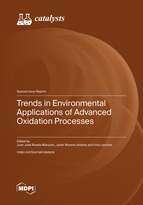Trends in Environmental Applications of Advanced Oxidation Processes
A special issue of Catalysts (ISSN 2073-4344). This special issue belongs to the section "Environmental Catalysis".
Deadline for manuscript submissions: closed (31 May 2023) | Viewed by 35346
Special Issue Editors
Interests: AOPs; photo-Fenton; catalytic wet peroxide oxidation; photocatalysis; contaminants of emerging concern (CECs); toxicity bioassays; urban and industrial wastewater treatment
Interests: water disinfection by means of advanced oxidation processes; water treatment related with maritime industry (such as aquaculture and ballast water management) and related impacts on the oceans health; technological processes for cyanobacterial and cyanotoxin removal
Interests: catalysis; water and wastewater treatment; advanced oxidation processes (AOPs); photocatalysis; thin films; SODIS; pathogen inactivation
Special Issues, Collections and Topics in MDPI journals
Special Issue Information
Dear Colleagues,
Advanced oxidation processes (AOPs) are promising techniques, which can be used for various environmental applications. Currently, AOPs are receiving an extensive amount of interest from many researchers mainly due to their non-selective behavior and potential for pollutant oxidation, and lack of solid waste formation for the majority of them. However, there are some knowledge gaps in scientific literature, such as the efficiency and applicability of AOPs for real environmental water and/or wastewater matrices, effectiveness of AOPs for toxicity reduction, influence of environmental conditions and constituents on AOPs, cost of studied treatment methods, etc. This Special Issue invites original research papers as well as reviews focused on various environmental applications of AOPs, including but not limited to the following areas:
- Application of AOPs for removal of organic pollutants (e.g., CECs) from water matrices of diverse origin;
- AOPs for inactivation of microorganisms, e.g., viruses, bacteria, including those with antibiotic resistance, etc.;
- Application of AOPs for toxicity reduction;
- Life cycle assessment of AOPs;
- Operational conditions and economic assessment.
Dr. Juan José Rueda-Márquez
Dr. Javier Moreno-Andrés
Dr. Irina Levchuk
Guest Editors
Manuscript Submission Information
Manuscripts should be submitted online at www.mdpi.com by registering and logging in to this website. Once you are registered, click here to go to the submission form. Manuscripts can be submitted until the deadline. All submissions that pass pre-check are peer-reviewed. Accepted papers will be published continuously in the journal (as soon as accepted) and will be listed together on the special issue website. Research articles, review articles as well as short communications are invited. For planned papers, a title and short abstract (about 100 words) can be sent to the Editorial Office for announcement on this website.
Submitted manuscripts should not have been published previously, nor be under consideration for publication elsewhere (except conference proceedings papers). All manuscripts are thoroughly refereed through a single-blind peer-review process. A guide for authors and other relevant information for submission of manuscripts is available on the Instructions for Authors page. Catalysts is an international peer-reviewed open access monthly journal published by MDPI.
Please visit the Instructions for Authors page before submitting a manuscript. The Article Processing Charge (APC) for publication in this open access journal is 2700 CHF (Swiss Francs). Submitted papers should be well formatted and use good English. Authors may use MDPI's English editing service prior to publication or during author revisions.
Keywords
- Advanced Oxidation Processes (AOPs)
- Municipal wastewater
- Industrial wastewater
- Microorganism inactivation
- Contaminants of emerging concern (CECs)
- Toxicity removal
- Life cycle assessment








